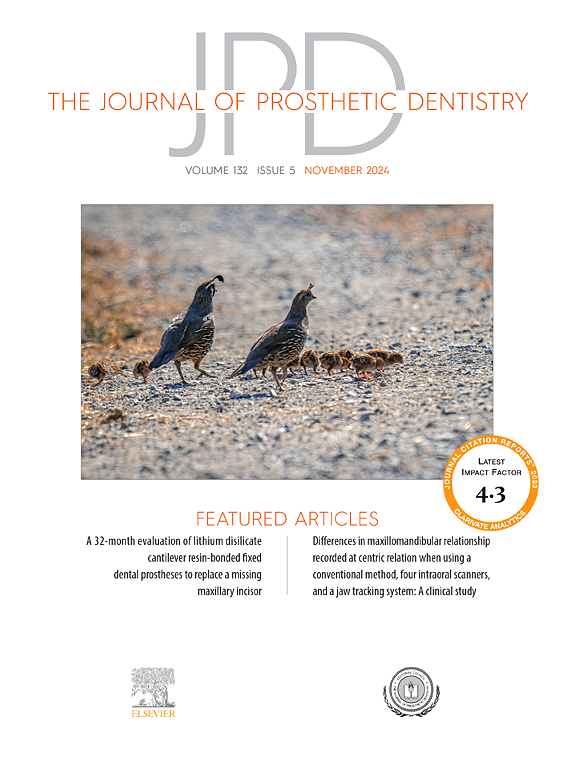Additive manufacturing of CAD-CAM complete arch fixed implant restorations supported by six implants: Prosthetic screw stability and marginal precision under masticatory simulation
IF 4.8
2区 医学
Q1 DENTISTRY, ORAL SURGERY & MEDICINE
引用次数: 0
Abstract
Statement of problem
Titanium frameworks for implant-supported fixed prostheses can be fabricated through subtractive or additive manufacturing using computer-aided design and computer-aided manufacturing (CAD-CAM) systems. However, the accuracy achieved by these technologies remains uncertain.
Purpose
The purpose of this in vitro study was to evaluate complete arch maxillary fixed prostheses supported by 6 implants using CAD-CAM frameworks manufactured by milling and 3D printing technologies, selective laser melting (SLM), and electron beam melting (EBM) on the marginal fit and screw loosening torque before and after masticatory simulation.
Material and methods
Ti-6Al-4V frameworks were manufactured by milling, SLM, and EBM technologies (n=5) and were subsequently ceramic veneered. The surface topography of the framework was assessed by scanning electron microscopy and laser scanning confocal microscopy. One-way analysis of variance (ANOVA) was used to evaluate surface area. The specimens were further evaluated for the dependent variables (marginal fit and screw loosening torque) before and after masticatory simulation. Two-way repeated measures ANOVA and the Pearson correlation were performed (α=.05).
Results
Topographical analysis demonstrated that the milling group had a smooth surface (surface area: 1.17 ±0.02 µm2) with regular regions, while additive manufacturing groups showed a dendritic profile with higher surface area (SLM: 1.23 ±0.05 µm2; EBM: 1.21 ±0.03 µm2; P<.05). A 2-way ANOVA found no interaction between technology and time (P>.05) for both dependent variables. Marginal fit showed no further significant differences regarding either the manufacturing technology or the evaluation time. Masticatory simulation reduced screw loosening torque (P=.032). Regarding manufacturing technology, milling resulted in a higher screw loosening torque compared with SLM (P=.01); however, no difference was observed between EBM and either SLM or milling (P>.05). A moderate correlation (P=.02) between marginal fit and screw loosening torque was observed only at baseline for the pooled CAD-CAM (milling, SLM, and EBM) specimens.
Conclusions
CAD-CAM complete arch fixed prostheses on 6 implants made by milling, SLM, and EBM exhibited marginal fit values below the acceptable error limits. Regarding prosthetic screw loosening torque, the pooled milled frameworks showed better values compared with SLM. After masticatory simulation, prosthetic screw stability decreased in all prostheses.
六种种植体支持的CAD-CAM全弓固定种植体修复体的增材制造:咀嚼模拟下假体螺钉稳定性和边缘精度。
问题说明:用于种植体支持的固定假体的钛框架可以通过使用计算机辅助设计和计算机辅助制造(CAD-CAM)系统的减法或增材制造来制造。然而,这些技术所达到的精度仍然不确定。目的:采用铣磨和3D打印技术制造的CAD-CAM框架、选择性激光熔化(SLM)和电子束熔化(EBM)技术,对6种种植体支撑的全弓上颌固定义体在模拟咀嚼前后的边缘配合和螺钉松动扭矩进行评估。材料和方法:通过铣削、SLM和EBM技术制造Ti-6Al-4V框架(n=5),随后进行陶瓷贴面。通过扫描电子显微镜和激光扫描共聚焦显微镜对骨架的表面形貌进行了评估。采用单因素方差分析(ANOVA)评价表面积。进一步评估了咀嚼模拟前后试件的因变量(边际配合和螺钉松动力矩)。进行双向重复测量方差分析和Pearson相关分析(α= 0.05)。结果:形貌分析表明,铣削组表面光滑(表面积为1.17±0.02µm2),区域规则;增材制造组表面呈枝晶状,表面积更高(SLM为1.23±0.05µm2;EBM: 1.21±0.03µm2;P.05)。边际拟合在制造技术和评价时间方面没有进一步的显著差异。咀嚼模拟降低了螺钉松动力矩(P= 0.032)。在制造工艺方面,铣削导致螺钉松动扭矩高于SLM (P= 0.01);然而,EBM与SLM或铣削之间没有差异(P < 0.05)。仅在混合CAD-CAM(铣削,SLM和EBM)样本的基线上观察到边际配合和螺钉松动扭矩之间的中度相关性(P= 0.02)。结论:采用铣削、SLM和EBM制作的6种种植体的CAD-CAM全弓固定假体的边缘拟合值低于可接受的误差范围。在假体螺钉松动力矩方面,与SLM相比,混合铣削框架具有更好的值。模拟咀嚼后,所有假体的螺钉稳定性下降。
本文章由计算机程序翻译,如有差异,请以英文原文为准。
求助全文
约1分钟内获得全文
求助全文
来源期刊

Journal of Prosthetic Dentistry
医学-牙科与口腔外科
CiteScore
7.00
自引率
13.00%
发文量
599
审稿时长
69 days
期刊介绍:
The Journal of Prosthetic Dentistry is the leading professional journal devoted exclusively to prosthetic and restorative dentistry. The Journal is the official publication for 24 leading U.S. international prosthodontic organizations. The monthly publication features timely, original peer-reviewed articles on the newest techniques, dental materials, and research findings. The Journal serves prosthodontists and dentists in advanced practice, and features color photos that illustrate many step-by-step procedures. The Journal of Prosthetic Dentistry is included in Index Medicus and CINAHL.
 求助内容:
求助内容: 应助结果提醒方式:
应助结果提醒方式:


